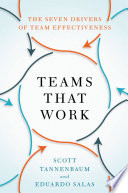

Team dynamics refer to the psychological and social processes that occur within a team. Understanding these dynamics is crucial because they can significantly influence team performance. The book emphasizes that successful teams are not merely a collection of individuals but a cohesive unit that works together towards common goals. The author discusses various factors that affect team dynamics, such as communication, trust, and conflict resolution. Effective communication fosters an environment where team members feel valued and understood, which enhances collaboration. Trust is another critical element; when team members trust each other, they are more likely to share ideas and take risks, leading to innovation. Additionally, the book highlights the importance of resolving conflicts constructively. Instead of avoiding disagreements, teams should address them openly to find solutions that benefit everyone. Ultimately, understanding and managing team dynamics can lead to improved performance and satisfaction among team members.
Continue readingDiversity within teams can lead to more innovative solutions and better decision-making. The book outlines how diverse teams bring together different perspectives, experiences, and skills, which can enhance creativity and problem-solving. The author argues that teams should strive for diversity not just in terms of demographics but also in thought and approach. However, the book also cautions that diversity can lead to challenges, such as misunderstandings and conflict. To harness the benefits of diversity, the author suggests implementing inclusive practices that encourage all team members to contribute their unique viewpoints. This includes fostering an open culture where everyone feels safe to express their ideas and concerns. By valuing diversity and creating an inclusive environment, teams can leverage their collective strengths to achieve exceptional results.
Continue readingClearly defined roles and responsibilities are essential for team effectiveness. The book explains that when team members understand their specific roles, they can work more efficiently and avoid overlap or confusion. The author emphasizes the importance of aligning individual strengths with team roles to maximize productivity. Each member should have a clear understanding of their responsibilities and how they contribute to the team's overall objectives. Additionally, the book suggests that roles should be flexible and adaptable to changing circumstances. As projects evolve, team members may need to take on different responsibilities or collaborate in new ways. By fostering an environment where roles can be adjusted as needed, teams can remain agile and responsive to challenges, ultimately enhancing their performance.
Continue readingThe leadership approach taken by team leaders can significantly impact team performance and morale. The book discusses various leadership styles, such as transformational, transactional, and servant leadership, and how each can affect team dynamics. Transformational leaders inspire and motivate their teams to exceed expectations by fostering a shared vision and encouraging personal growth. On the other hand, transactional leaders focus on structure and rewards, which can be effective in more traditional settings. Servant leadership, which prioritizes the needs of team members, is also highlighted as a way to build trust and collaboration. The author emphasizes that effective leaders should adapt their style to the team's needs and the specific context of their work. By understanding the nuances of different leadership approaches, team leaders can cultivate an environment that promotes engagement and high performance.
Continue readingSetting clear, achievable goals is fundamental to team success. The book outlines the importance of establishing specific, measurable, attainable, relevant, and time-bound (SMART) goals. By having well-defined objectives, teams can focus their efforts and track progress effectively. The author also discusses the role of accountability in achieving these goals. When team members are held accountable for their contributions, they are more likely to stay committed and motivated. The book suggests implementing regular check-ins and feedback loops to monitor progress and address any obstacles that may arise. This ongoing communication helps maintain alignment and encourages collaboration. Ultimately, by prioritizing goal setting and accountability, teams can enhance their performance and achieve their desired outcomes.
Continue readingThe need for continuous learning and development is a recurring theme throughout the book. The author argues that in today's fast-paced and ever-changing environment, teams must be adaptable and willing to learn. This includes not only acquiring new skills but also reflecting on past experiences to identify areas for improvement. The book emphasizes the importance of creating a culture of learning within teams, where members are encouraged to share knowledge and support each other's growth. This can be achieved through regular training sessions, workshops, and team-building activities. Additionally, the author highlights the value of feedback in the learning process. Constructive feedback can help team members understand their strengths and weaknesses, enabling them to improve and contribute more effectively to the team. By fostering a culture of continuous learning, teams can remain competitive and innovative.
Continue readingTechnology plays a vital role in facilitating collaboration among team members, especially in remote or distributed teams. The book discusses various tools and platforms that can enhance communication, project management, and information sharing. The author emphasizes that while technology can improve efficiency, it is essential to choose the right tools that align with the team's needs and culture. The book also cautions against over-reliance on technology, as it can lead to disengagement and isolation among team members. Instead, the author advocates for a balanced approach that combines technology with effective interpersonal communication. By leveraging technology thoughtfully, teams can enhance collaboration and streamline their workflows, ultimately improving their performance.
Continue reading